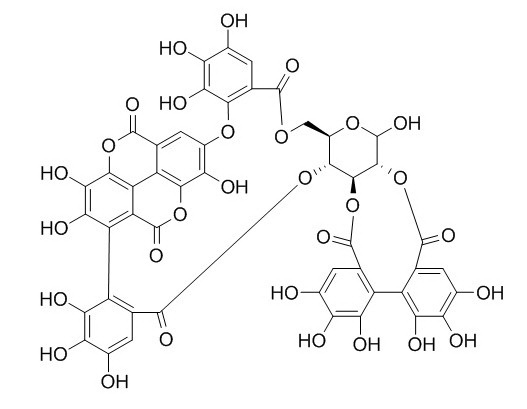Terchebulin
Terchebulin has potentiality as an anti-acne agent, it shows good antibacterial activity against Propionibacterium acnes, minimum inhibitory concentration (MIC) = 125 ug/ml and minimum bactericidal concentration (MBC) = 250 ug/ml.Terchebulin, flavogallonic acid and punicalagin have antiplasmodial activity, the IC50s of them range between 8-21 microg/ml (8-40 microM) against Plasmodium falciparum 3D7 and K1.
Inquire / Order:
manager@chemfaces.com
Technical Inquiries:
service@chemfaces.com
Tel:
+86-27-84237783
Fax:
+86-27-84254680
Address:
1 Building, No. 83, CheCheng Rd., Wuhan Economic and Technological Development Zone, Wuhan, Hubei 430056, PRC
Providing storage is as stated on the product vial and the vial is kept tightly sealed, the product can be stored for up to
24 months(2-8C).
Wherever possible, you should prepare and use solutions on the same day. However, if you need to make up stock solutions in advance, we recommend that you store the solution as aliquots in tightly sealed vials at -20C. Generally, these will be useable for up to two weeks. Before use, and prior to opening the vial we recommend that you allow your product to equilibrate to room temperature for at least 1 hour.
Need more advice on solubility, usage and handling? Please email to: service@chemfaces.com
The packaging of the product may have turned upside down during transportation, resulting in the natural compounds adhering to the neck or cap of the vial. take the vial out of its packaging and gently shake to let the compounds fall to the bottom of the vial. for liquid products, centrifuge at 200-500 RPM to gather the liquid at the bottom of the vial. try to avoid loss or contamination during handling.
J Ginseng Res.2023, 47(4):593-603.
Food Res Int.2018, 106:909-919
Research Square2023, 2883170.
Org Biomol Chem.2017, 15(31):6483-6492
J Asian Nat Prod Res.2019, 5:1-17
Metabolites.2020, 10(12):497.
Neurochem Int.2018, 121:114-124
In Vivo.2022, 36(3):1136-1143.
Molecules.2023, 28(13):4971.
Front Plant Sci.2022, 13:982771.
Related and Featured Products
Parasitol. Res., 2008, 102(6):1119-27.
The use of microfluorometric method for activity-guided isolation of antiplasmodial compound from plant extracts.[Pubmed:
18214539 ]
In vitro antiplasmodial activity of methanolic extracts of 16 medicinal plants was evaluated by fluorometric assay using PicoGreen.
METHODS AND RESULTS:
The IC50s, as determined by parasite DNA concentration, ranged from <11 to >200 and <13 to >200 microg/ml for Plasmodium falciparum 3D7 and K1, respectively; and the most active extracts were those from Anogeissus leiocarpus and Terminalia avicennoides (<11-> or =14 microg/ml). Aqueous, butanolic, ethyl acetate, and methanolic fractions of these two extracts revealed butanolic fraction to have a relatively better activity (IC50, 10-12 microg/ml). Activity-guided chromatographic separation of the butanolic fraction on Sephadex LH-20 followed by nuclear magnetic resonance and correlation high-performance liquid chromatography revealed the presence of known hydrolysable tannins and some related compounds-castalagin, ellagic acid, flavogallonic acid, punicalagin, Terchebulin, and two other fractions.
CONCLUSIONS:
The IC50s of all these compounds ranged between 8-21 microg/ml (8-40 microM) against both the strains. Toxicity assay with mouse fibroblasts showed all the extracts and isolated compounds to have IC50 > or = 1500 microg/ml, except for Momordica balsamina with <1500 microg/l. All the extracts and isolated compounds did not affect the integrity of human erythrocyte membrane at the observed IC50s. However, adverse effects manifest in a concentration-dependent fashion (from IC50 > or = 500 microg/ml).
J. Wood Sci., 2013, 59(5):426-31.
Anti-acne activity of tannin-related compounds isolated from Terminalia laxiflora[Reference:
WebLink]
In our investigation to find out new anti-acne agent, we focused on Terminalia laxiflora Engl & Diels (Combretaceae) methanolic wood extract, which has been selected during previous screening experiments for anti-acne agents, which included 29 species of Sudanese medicinal plants.
METHODS AND RESULTS:
Based on the biologically guided fractionation using an antibacterial assay against Propionibacterium acnes, a lipase inhibitory assay and 1,1-diphenyl-2-picrylhydrazyl (DPPH) radical scavenging activity assay; five tannin-related compounds were isolated, such as ellagic acid, flavogallonic acid dilactone, Terchebulin and gallic acid. Terchebulin showed good antibacterial activity; minimum inhibitory concentration (MIC) = 125 μg/ml and minimum bactericidal concentration (MBC) = 250 μg/ml. Gallic acid exhibited lipase inhibitory activity with IC50 value of 149.3 μM, which showed strong inhibition compared with Terchebulin, IC50 260.7 μM. However, all compounds exhibited better or equal DPPH radical scavenging activity to (+)-catechin as positive control. Ellagic acid and Terchebulin showed the best DPPH radical scavenging activities, IC50 4.86 and 4.90 μM, respectively.
CONCLUSIONS:
This study demonstrated that Terchebulin has potentiality as an anti-acne agent.



